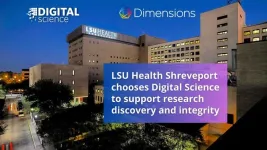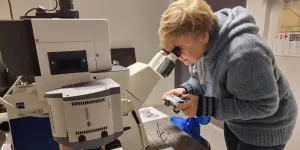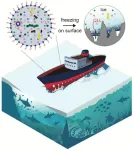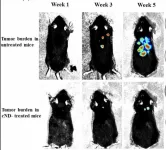(Press-News.org) DALLAS, Nov. 28, 2023 — More than 4,000 abstracts were presented during the American Heart Association’s Scientific Sessions 2023 and Resuscitation Science Symposium 2023, held earlier this month in Philadelphia. Here are some of the important scientific findings that could impact your heart and stroke health.
Next wave of AI prediction models aims to predict risk of heart attack and stroke, as well as heart valve disease
Artificial intelligence (AI) and deep learning models may help to predict the risk of cardiovascular disease events and detect heart valvular disease, according to two preliminary research studies.
One study found that artificial intelligence analyzing sound data of the heart recorded from a digital stethoscope was able to more accurately detect heart valve disease than a health care professional who listened to the heart with a traditional stethoscope.
In another study, an AI/deep learning program effectively analyzed and sorted eye images of people with prediabetes and Type 2 diabetes to determine their risk of cardiovascular disease events, like heart attack and stroke.
“Computational methods to develop novel predictors of health and disease — ‘artificial intelligence” — are becoming increasingly sophisticated,” said Dan Roden, M.D., FAHA, professor of medicine, pharmacology and biomedical informatics and senior vice-president for personalized medicine at Vanderbilt University Medical Center, as well as chair of the Association’s Council on Genomic and Precision Medicine. “Both of these studies take a measurement that is easy to understand and easy to acquire and ask what that measurement predicts in the wider world.”
Depressed? Anxious? Stressed? These could put you on the fast track to heart disease risk
A study found that depression and anxiety may speed development of risk factors, like high blood pressure, high cholesterol or Type 2 diabetes, that increase heart attack and stroke risk. Participants previously diagnosed with anxiety or depression developed a new risk factor on average six months earlier than those who did not have depression or anxiety. Depression and anxiety increased the risk for a major cardiovascular event, such as a heart attack or stroke, by about 35%.
A second study found that cumulative stress increased the risk of poor heart and brain health in two ways: by directly influencing physical well-being and increasing poor lifestyle behaviors, such as smoking and being sedentary, according to two new studies.
“There are clear associations between psychological health and cardiovascular disease risk. These studies add to a growing body of data we have on how negative psychological health can increase the risk of heart and brain disease, They illustrate that health care professionals should be aware that negative psychological health — things like depression or anxiety — not only affect patient’s mental state of being, but also can impact their physical health and the risk for heart disease. So, these are not benign conditions, these are things for which we want to aggressively refer people to mental health professionals,” said Glenn N. Levine, M.D., FAHA, writing committee chair of the American Heart Associations’ 2021 Psychological Health, Well-Being, and the Mind-Heart-Body Connection scientific statement and master clinician and professor of medicine at Baylor College of Medicine, chief of the cardiology section at the Michael E. DeBakey VA Medical Center, both in Houston.
AHA health information: How does stress affect the body?
Heart disease risk higher among transgender adults in rural U.S.
In a small study of adults living in the rural America, those who identified as transgender were more likely to have heart disease risk factors, like tobacco use, obesity and high blood pressure, than their cisgender peers. Transgender males had the highest odds of having cardiovascular disease risk factors.
Transgender adults were more than six times more likely to use tobacco and almost four times more likely to have prediabetes or Type 2 diabetes. And those in the trans-male group were 13 times more likely to be obese.
“The findings of this small study highlight two critical areas of concern – the potential increased cardiovascular risk among transgender people, along with the increased cardiovascular risk among people living in rural areas. These disparity gaps pack a one-two punch to our transgender patients and communities for a number of reasons,” said Carl Streed Jr., M.D., M.P.H., F.A.C.P., F.A.H.A. volunteer chair of the writing group for the American Heart Association statement on transgender and gender diverse populations, an assistant professor of internal medicine at Boston University School of Medicine and the research lead at the GenderCare Center at Boston Medical Center. “The physical risks are likely heightened by the mental stress that many LGBTQ+ people encounter due to discrimination that is often more prevalent in rural America, especially among states with policies limiting access to gender affirming care. The American Heart Association supports the need for more research and initiatives to ensure equitable health and health care for all people, especially persons and communities most at risk due to various diversity gaps in care whether they are based on racial, ethnic, sexual and/or gender identities, socioeconomic status or geography.”
AHA health initiative: Pride with Heart
A child’s race, ethnicity, neighborhood might influence survival after cardiac arrest
Children can have cardiac arrests, too. And when they do, their race, ethnicity or neighborhood might impact survival and recovery, according to a new study.
Hispanic and white children had similar odds of surviving and coming out of cardiac arrest in good neurological health. Black children were 26% less likely to survive to hospital discharge and 36% less likely to survive without neurological issues that kept them from fully resuming their daily lives.
“The results from this observational work are compelling because the measured disparities in recovery are magnitudes different among white and Hispanic children in comparison to Black children,” said Sarah Perman, M.D., M.S.C.E., FAHA, an associate professor in the department of emergency medicine at Yale School of Medicine and chair of the Association’s Resuscitation Science Symposium 2023. “Exploring the drivers of these differences will be necessary to address the disparities in outcomes. Determining the reasons why Black children had cardiac arrest at a greater incidence also warrants more research in order to combat differences and develop services, programs and diagnostics that will work to reduce these measured observations.”
Learning to save lives can start as early as age 4, according to new scientific statement (May 2023)
Dying young: American Indian and Alaska Native adults have higher rates of death from early heart attacks—before age 55 for men, before 65 for women
American Indian and Alaska Native adults had significantly higher death rates from premature heart attacks compared to white, Black and Asian/Pacific Islander adults in the U.S., according to an analysis of more than 370,000 heart attack deaths from 1999-2020.
In addition, despite an overall decrease in heart attack death rates among American Indian and Alaska Native adults during the last two decades, heart attack-related deaths in American Indian and Alaska Native adult men younger than 55 years old and women younger than 65 years old did not decrease.
“With over 574 federally recognized tribes in the U.S., it is impossible for one such as myself to speak for all American Indian/Alaska Native people. However, the data are compelling and show high rates of preventable illness at younger ages than in other populations,” said Allison Kelliher, M.D., a research associate at the Johns Hopkins School of Nursing and a senior research associate at the Bloomberg School of Public Health Center for Indigenous Health, both in Baltimore. Kelliher, who is Koyukon Athabascan, Dena, from Nome, Alaska, is vice chair of the Association’s 2023 scientific statement Status of Maternal Cardiovascular Health in American Indian and Alaska Native Individuals and founder and former director of the American Indian Collaborative Research Network (AICoRN). “As a family physician, biomedical researcher and Traditional Alaska Native Healer, I see ways that we can adapt and implement appropriate and successful programs to prevent and treat tobacco use, more effectively promote healthy body weight and address other factors that increase our risk of cardiovascular disease, such as cholesterol, blood sugar and blood pressure. We need to better develop culturally safe and appropriate programs and supports that are effective and accessible. In addition, we have an opportunity here, especially in informed Alaska Indigenous/Alaska Native communities, to work toward addressing our own individual and collective heart health.”
Think marijuana is heart safe? Think again.
As more people across the U.S. use marijuana for medical and recreational reasons, two new studies suggest its regular intake may damage heart and brain health.
In one study, daily use of marijuana raised the risk of developing heart failure by about one-third, even after considering other factors, compared to people who reported never using marijuana.
In a second study, older people with any combination of Type 2 diabetes, high blood pressure and high cholesterol who used marijuana, significantly increased their risk for a major acute heart or brain event while hospitalized, compared to those who reported not using marijuana.
“The latest research about cannabis use indicates that smoking and inhaling cannabis increases concentrations of blood carboxyhemoglobin (carbon monoxide, a poisonous gas), tar (partly burned combustible matter) similar to the effects of inhaling a tobacco cigarette, both of which have been linked to heart muscle disease, chest pain, heart rhythm disturbances, heart attacks and other serious conditions,” said Robert L. Page II, Pharm.D., M.S.P.H., FAHA, chair of the volunteer writing group for the 2020 American Heart Association Scientific Statement: Medical Marijuana, Recreational Cannabis, and Cardiovascular Health. “Together with the results of these two research studies, the cardiovascular risks of cannabis use are becoming clearer and should be carefully considered and monitored by health care professionals and the public.”
Experimental pacemaker converts heartbeat energy to recharge battery
A new study found that an experimental, leadless pacemaker housing is able to partially recharge the device’s battery by generating electrical energy from heartbeats.
The device generated about 10% of the energy needed to stimulate another heartbeat.
The preliminary findings show that leadless pacemaker batteries may be recharged by converting the heart’s mechanical/pressure energy into electrical energy.
“This experimental study provides valuable information on harvesting energy from the heart to recharge pacemaker batteries. These new devices could also improve patients’ quality of life by requiring fewer procedures as they are smaller and last longer,” said Kenneth A. Ellenbogen, M.D., FAHA, co-author of the 2018 ACC/AHA/HRS Guideline on the Evaluation and Management of Patients With Bradycardia and Cardiac Conduction Delay, and the Kimmerling Professor of Cardiology at the VCU School of Medicine in Richmond, Virginia.
Air pollution-related hospitalization for chest pain, heart attack differed by seasons
Short-term increases in fine particulate air pollution (PM2.5) during the summer and winter months in a mountain valley region of Utah were associated with increased health care visits for heart attack and unstable chest pain; however, the risk for each cardiac event differed by season, according to a preliminary study.
Smoke from summertime wildfires that created short-term spikes in fine particulate matter air pollution was significantly associated with same-day hospitalization for unstable chest pain in Utah.
In contrast, during the wintertime, when pollution from human sources, such as vehicle exhaust, is more concentrated, data indicates people waited about two weeks before seeking treatment for unstable chest pain.
In addition, people sought same-day treatment for heart attacks during the wintertime exposure to air pollution, while in the summertime, there was no significant increase in same-day hospitalizations for heart attack.
“Air pollution is widely recognized as a significant contributor to cardiovascular disease and death and one we can modify by reducing exposure. Reversing the negative impacts of poor air quality on cardiovascular health is essential,” said Joel D. Kaufman, M.D., M.P.H., FAHA, a professor of environmental and occupational health sciences, professor of epidemiology and professor of medicine - general internal medicine at the University of Washington in Seattle, and chair of the writing group for the Association’s 2020 policy statement “Guidance to Reduce Cardiovascular Burden of Ambient Air Pollutants.”
AHA scientific statement: Personal-Level Protective Actions Against Particulate Matter Air Pollution Exposure
Following “Life’s Essential 8” checklist may slow biological aging by 6 years
An analysis of more than 6,500 adults found that having high cardiovascular health — as measured by the American Heart Association’s Life’s Essential 8 checklist — may slow the pace of biological aging, which may reduce the risk of developing cardiovascular and other age-related diseases while extending life,
After accounting for a range of socioeconomic factors, adults with high cardiovascular health were about six years younger biologically than their chronological age.
“These findings help us understand the link between chronological age and biological age and how following healthy lifestyle habits can help us live longer. Everyone wants to live longer, yet more importantly, we want to live healthier longer so we can really enjoy and have good quality of life for as many years as possible,” said Donald M. Lloyd-Jones, M.D., Sc.M., FAHA, chair of the writing group for Life’s Essential 8, a past volunteer president of the American Heart Association, the chair of the department of preventive medicine, the Eileen M. Foell Professor of Heart Research and professor of preventive medicine, medicine and pediatrics at Northwestern University’s Feinberg School of Medicine in Chicago.
Traumatic events may exacerbate the effects of poor sleep on children’s heart health
A new study found that traumatic events experienced during childhood may magnify the negative health effects of too much or too little sleep on children’s cardiovascular health.
More than one-third of the children did not meet recommended sleep standards — by either not getting enough sleep or by sleeping too much.
Each additional traumatic event increased by 8% the likelihood that a child was sleeping 1-2 hours less or 1+ hours more than recommended; or increased by 26% the likelihood that a child was sleeping 2+ hours less than recommended.
“The study found that traumatic events exacerbate the effects of poor sleep on children's health, and I’m not surprised by those findings. So much of what we experience every day impacts the quality and the duration of our sleep,” said Carissa Baker-Smith, M.D., M.P.H., M.S., FAHA, director of pediatric preventive cardiology at the Nemours Children’s Hospital in Wilmington, Delaware, and a co-author of the Association’s 2023 scientific statement on Pediatric Primary Hypertension. “Parents need to understand that our mental health plays an extreme extremely important role in how we sleep and on the quality and the duration of our sleep. If children are experiencing changes in mental health, like depression or anxiety, those are important things to discuss, to address and to work towards solving.”
Sleep Your Way to Whole Body Health
Drones could soon be deployed to speed delivery of life-saving automated external defibrillators (AEDs) to people having cardiac arrests—even if those people are in remote, rural areas of the U.S.
A research simulation suggests that a drone delivery system could improve access to automated external defibrillators (AEDs), a portable device that can shock the heart rhythm back to normal when a person is experiencing an out-of-hospital cardiac arrest.
The simulation found that delivering AEDs by drone improved the five-minute response time for AED arrival from 24% to 77% for urban areas and 10% to 23% for rural areas.
The research team conducting the simulation has received an American Heart Association Health Equity Research Network grant to investigate solutions to rural health inequities. As part of that research project, they are currently working on the real-life implementation of drone-delivered AEDs in North Carolina and will be using these new findings to further refine their drone delivery system.
Learn why time to AED matters: 9 in 10 cardiac arrest victims who receive a shock from an AED in the first minute live. AED fact sheet - SDW (heart.org)
Out-of-hospital cardiac arrest survivors in Black and Hispanic communities are less likely than survivors in white communities to live to hospital discharge
This study found that Black and Hispanic people who were resuscitated and survived cardiac arrest in the community setting were more likely than white people to suffer neurologic problems or die before hospital discharge, potentially due to the quality measures of the hospital to which they are admitted
Among people from Black communities who were admitted to the hospital after initially surviving cardiac arrest, 19.7% had positive outcomes, compared to 22.1% of Hispanic people and 33.5% of white people.
AHA health initiative: Join the Nation of Lifesavers™
Realizing cardiac arrest’s toll on caregivers (and what could help ease caregiver distress)
Family members of people who survive cardiac arrest are often quickly placed in a position to make decisions concerning their loved one’s medical care.
In a study to evaluate an informational pamphlet to help caregivers feel more knowledgeable and better able to make decisions regarding their loved ones’ care, researchers found the pamphlet eased the decision-making process for 90% of the caregivers in the study.
A second study found most caregiver participants reported some form of psychological distress, with 66% experiencing anxiety; 29% experiencing characteristics of PTSD; and 57% showing signs of moderate depression. “Increased access to the care team” and “increased information on potential recovery,” were ranked as the most helpful interventions offered to caregivers.
“As systems, processes and education surrounding emergency procedures and treatment for cardiac arrest improve, the number of people who survive a sudden cardiac arrest is increasing,” said Katie Dainty, Ph.D., a member of the American Heart Association CPR and ECC guidelines writing group and research chair in patient-centered outcomes at North York General Hospital in Toronto, Canada. “While survival from cardiac arrest looks different for each patient, there are numerous decisions that must be made surrounding that person’s acute and long-term medical treatment, psycho-social needs and recovery. In many ways, family members and surrogate decision-makers are ‘co-survivors’ of this life-altering event and it is crucial that we turn our attention to understanding their evolving emotional, physical and informational needs as they navigate their new life and roles.”
AHA Scientific Statement: Sudden Cardiac Arrest Survivorship, February 2020
Co-authors, disclosures and funding sources are listed in the abstracts.
Statements and conclusions of studies that are presented at the American Heart Association’s scientific meetings are solely those of the study authors and do not necessarily reflect the Association’s policy or position. The Association makes no representation or guarantee as to their accuracy or reliability. Abstracts presented at the Association’s scientific meetings are not peer-reviewed, rather, they are curated by independent review panels and are considered based on the potential to add to the diversity of scientific issues and views discussed at the meeting. The findings are considered preliminary until published as a full manuscript in a peer-reviewed scientific journal.
The Association receives funding primarily from individuals; foundations and corporations (including pharmaceutical, device manufacturers and other companies) also make donations and fund specific Association programs and events. The Association has strict policies to prevent these relationships from influencing the science content. Revenues from pharmaceutical and biotech companies, device manufacturers and health insurance providers and the Association’s overall financial information are available here.
About the American Heart Association
The American Heart Association is a relentless force for a world of longer, healthier lives. We are dedicated to ensuring equitable health in all communities. Through collaboration with numerous organizations, and powered by millions of volunteers, we fund innovative research, advocate for the public’s health and share lifesaving resources. The Dallas-based organization has been a leading source of health information for nearly a century. Connect with us on heart.org, Facebook, X or by calling 1-800-AHA-USA1.
###
END
Recent scientific studies offer insight into heart and stroke health
The American Heart Association summarizes new, key findings from its annual scientific meetings that could help people with cardiovascular disease
2023-11-28
ELSE PRESS RELEASES FROM THIS DATE:
Montefiore Einstein Comprehensive Cancer Center awarded FDA grant for clinical trial on experimental AML/MDS treatment
2023-11-28
November 28, 2023—(BRONX, NY)—Acute myeloid leukemia (AML) and myelodysplastic syndromes (MDS)—two related blood diseases that disproportionally strike older adults—are notoriously difficult to treat and associated with high relapse rates. Although new therapies have improved survival, treatment options remain limited, and the prognosis for the 50% of people who experience disease relapse remains poor.
Researchers at the National Cancer Institute-designated Montefiore Einstein Comprehensive ...
LSU Health Shreveport chooses Digital Science to support research discovery and integrity
2023-11-28
Digital Science, a technology company serving stakeholders across the research ecosystem, is pleased to announce that Louisiana State University Health Shreveport (LSUHS) has chosen Dimensions Analytics and Dimensions Research Security from Digital Science’s flagship products to advance its world-class research programs.
LSUHS is one of the first customers to subscribe to the new Dimensions Research Security app. The institution – one of the leading health science research programs in the U.S. – has signed a three-year deal to utilize the two products ...
Understanding the impact of transferring patients with dementia between hospitals
2023-11-28
INDIANAPOLIS – It is common for individuals seeking medical care for symptoms of concern to go to the nearest hospital. Physicians there may determine the facility cannot provide the care they believe the patient needs and recommend transfer to another hospital offering a higher level of care or specialized services.
In a recent study, researchers from Regenstrief Institute and Indiana University School of Medicine reviewed electronic health records to compare older adults with dementia transferred to another hospital with older adults who did not have dementia. The researchers found significant differences in treatment following transfer.
Patients with dementia more ...
The secret life of an electromagnon
2023-11-28
Scientists have revealed how lattice vibrations and spins talk to each other in a hybrid excitation known as an electromagnon. To achieve this, they used a unique combination of experiments at the X-ray free electron laser SwissFEL. Understanding this fundamental process at the atomic level opens the door to ultrafast control of magnetism with light.
Within the atomic lattice of a solid, particles and their various properties cooperate in wave like motions known as collective excitations. When atoms in a lattice jiggle together, the collective excitation is known as a phonon. Similarly, when the atomic spins - the magnetisation of the atoms -move together, it’s ...
New method identifies bacteria more easily
2023-11-28
Far too many antibiotics are used around the world. As a result, bacteria are becoming resistant.
Curing bacterial diseases is becoming more difficult than before, because antibiotics are perhaps our foremost weapons in the fight against them.
An important step towards using fewer antibiotics is to find better methods for identifying pathogens, and here is the good news.
“We have developed a simple tool that can identify all of the genetic material in bacteria. This allows us to find out more quickly what kind of bacteria a sick person or animal is affected ...
Bidding adieu to sticky ice, but with a grain of salt
2023-11-28
As Americans gear up for winter, many will face one of their toughest foes: ice. From delaying flights to making roads slippery, ice accumulation on surfaces wreaks havoc in many ways.
But not all ice is created equal. In new research from the University of Illinois Chicago, scientists studied the stickiness of ice containing everyday contaminants such as salt, soap and alcohol. Most laboratory studies typically test ice made from pure water, but in nature, ice is seldom pure.
“Be it dirty sidewalks or the hull of ...
CHOP researchers define seizure burden, developmental outcomes for STXBP1-related disorders
2023-11-28
Philadelphia, November 28, 2023 – Researchers from Children’s Hospital of Philadelphia (CHOP) found that seizure patterns and response to treatment strategies were able to help clinical teams determine epilepsy and developmental trajectories for patients with STXBP1-related disorders, one of the most common genetic epilepsy disorders. The findings were published online by the journal Brain.
Disease-causing variants in the gene STXBP1 are implicated in one of the most common genetic epilepsies and neurodevelopmental disorders, which are sometimes accompanied by autism spectrum disorder, increased or decreased muscle tone, or movement disorders. ...
Researchers identify three genes associated with neurodevelopmental disorders
2023-11-28
An international study group led by researchers of Children’s Hospital of Philadelphia (CHOP) have identified how three novel genes cause neurodevelopmental disorders. Researchers now have a better sense of the genes’ roles in human brain development and function and their ability to serve as potential therapeutic targets in the future. The findings were recently published online by the Journal of Clinical Investigation.
Over the last couple of decades, researchers have identified more than 1500 genes in different signaling pathways associated ...
Miss America’s Scholarship Foundation joins Go Red for Women to champion women’s health and well-being at every age
2023-11-28
DALLAS, November 28, 2023 — Cardiovascular disease (CVD) claims more lives than all forms of cancer, yet many women, particularly younger women, remain unaware.[1] Through its Go Red for Women® movement, the American Heart Association, which is devoted to a world of healthier lives for all, is being supported by Miss America’s Scholarship Foundation to empower the next generation of women to take charge of their health and make a lasting impact on the health and well-being of communities nationwide.
The ...
Nanodiamonds block tumor metastasis in mice
2023-11-28
Nanodiamonds are 2-8 nm carbon nanoparticles, which can be easily functionalized with various chemical groups like carboxylic groups or drugs. Previous research has shown that actively dividing cells are more likely to absorb nanodiamonds and that epithelial cells treated with carboxylic nanodiamonds lose the ability to migrate across cell permeable cellulose membranes. Rajiv K. Saxena and colleagues explored whether nanodiamonds might block tumor metastasis, a process that requires cell migration to new areas. The authors treated B16F10 melanoma cells with carboxylic nanodiamonds in culture and tested their ability to migrate and ...
LAST 30 PRESS RELEASES:
Making lighter work of calculating fluid and heat flow
Normalizing blood sugar can halve heart attack risk
Lowering blood sugar cuts heart attack risk in people with prediabetes
Study links genetic variants to risk of blinding eye disease in premature infants
Non-opioid ‘pain sponge’ therapy halts cartilage degeneration and relieves chronic pain
AI can pick up cultural values by mimicking how kids learn
China’s ecological redlines offer fast track to 30 x 30 global conservation goal
Invisible indoor threats: emerging household contaminants and their growing risks to human health
Adding antibody treatment to chemo boosts outcomes for children with rare cancer
Germline pathogenic variants among women without a history of breast cancer
Tanning beds triple melanoma risk, potentially causing broad DNA damage
Unique bond identified as key to viral infection speed
Indoor tanning makes youthful skin much older on a genetic level
Mouse model sheds new light on the causes and potential solutions to human GI problems linked to muscular dystrophy
The Journal of Nuclear Medicine ahead-of-print tip sheet: December 12, 2025
Smarter tools for peering into the microscopic world
Applications open for funding to conduct research in the Kinsey Institute archives
Global measure underestimates the severity of food insecurity
Child survivors of critical illness are missing out on timely follow up care
Risk-based vs annual breast cancer screening / the WISDOM randomized clinical trial
University of Toronto launches Electric Vehicle Innovation Ontario to accelerate advanced EV technologies and build Canada’s innovation advantage
Early relapse predicts poor outcomes in aggressive blood cancer
American College of Lifestyle Medicine applauds two CMS models aligned with lifestyle medicine practice and reimbursement
Clinical trial finds cannabis use not a barrier to quitting nicotine vaping
Supplemental nutrition assistance program policies and food insecurity
Switching immune cells to “night mode” could limit damage after a heart attack, study suggests
URI-based Global RIghts Project report spotlights continued troubling trends in worldwide inhumane treatment
Neutrophils are less aggressive at night, explaining why nighttime heart attacks cause less damage than daytime events
Menopausal hormone therapy may not pose breast cancer risk for women with BRCA mutations
Mobile health tool may improve quality of life for adolescent and young adult breast cancer survivors
[Press-News.org] Recent scientific studies offer insight into heart and stroke healthThe American Heart Association summarizes new, key findings from its annual scientific meetings that could help people with cardiovascular disease





